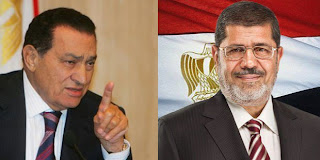 |
| 10 differences between Mubarak’s and Morsi’s trials |
CAIRO: Two years, three months and two days separate the trial of toppled President Hosni Mubarak and his successor Mohamed Morsi.
Below is a compiled list of ten differences between the two trials, starting from the charges filed against each of them, the details of the trials and even the clothes they chose to wear.
The trial:
Mosi’s trial date was scheduled four months after the June 30 mass protests, which called on the army to depose the Islamist president from his post, while Mubarak’s trial started seven months after the January 25 Revolution, which forced him to step down from his 30-year-reign.
The charges:
Mubarak, his two sons Alaa and Gamal along with former Minister of Interior Habib al-Adly, were charged with killing protestors during the January 25 Revolution, while Morsi was accused of first-degree murder and inciting his supporters to commit violence against those who opposed him.
Mubarak’s training suit and Morsi’s suit:
There is a great contrast between how the two former presidents appeared on their first trial session, with Mubarak dressed in a white training suit, sun glasses and lying back on a stretcher. Morsi, on the other hand, refused to put on the official uniform for the trial and insisted on wearing a black suit to show disregard for the court.
A zombie vs. a make-believe president:
Mubarak’s tactic to approach the courtroom was to act as though he was lying on his death bed, breathing in his last breaths. While Morsi has never looked more alive, he appeared strong, smiling and giving looks to the people around him, including the judge, as though he is still the one in charge and they were all there to serve him.
Attendance call:
When Judge Ahmed Refaat, presiding over Mubarak’s trial, called out the defendant’s name, the former president replied, ever so complacently, with, “yes judge …I am present.” On the contrary, Morsi’s reaction to the judge was far from compliant, refusing to address his questions and asking that he be released so he could resume his job running the country since he insisted that he was still Egypt’s legitimate president.
Trial broadcasting:
Mubarak’s first trial session was broadcast on the August 3, 2011, while Morsi’s trial was not aired due to security concerns, according to the court. However, scenes recorded from within the courtroom were later broadcast.
Morsi’s microbus vs. Mubarak’s private jet:
Morsi, along with a number of security officials, arrived at the court in the Police Academy in a small microbus, while Mubarak was transferred from Tora Prison to the same place in a private airplane.
Place of detention:
Mubarak was imprisoned in Tora prison, with his location announced, while Morsi came from an undisclosed location that nobody knew about, including him.
2000 soldiers against 20,000:
The security forces were on high alert before Morsi’s trial due to threats from his supporters to blow up the court and release him. As a result, 20,000 soldiers were deployed to secure the trial as opposed to a mere 2000 soldiers at Mubarak’s trial.
Arab countries’ position:
Arab States were in favor of Morsi’s trial, with Kuwait, Saudi Arabia, Bahrain and other countries supporting the road map prepared by Egypt’s military. However, those same countries were opposed to Mubarak’s trial.
